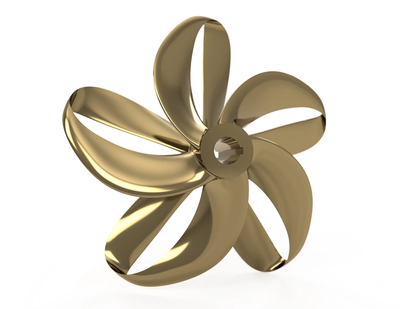MarineLink has a report on a new propeller design claimed to be “9-15 percent more efficient than the industry standard Wageningen B-series design” It is also claimed that new design can be “manufactured to meet a comparable price point to standard propellers.”
“Sharrow’s propeller product provides a wider peak efficiency curve for greater utility over a wide scope of operational ranges, and a 17 percent reduction in torque while accelerating. “
Fuel is a major part of Coast Guard operating costs. That degree of increased efficiency would make a huge difference in fuel economy. .
Looks like each blade consist of two parts connected at root and tip, with a gap in between. Visualizing the fluid flow over the blades is quite intriguing. I presume the gap allows accelerated flow over the forward face of the following blade half and that the joined tip prevents some loss of efficiency by decreasing span wise flow on the underside of the leading blade half and on the upper surface of the following blade half.
Could these be applied to the same effect to Variable Pitch propellers?
Makes me wonder if a similar design might not work on an airplane as well, both as a propeller and perhaps as a wing.


Curtis, I had the same initial thought regarding aircraft propellers as well, but their blades are much narrower than the wide blades needed ship propellers. It kind of reminds me of the same principle in structural engineering regarding trusses. The spaces are not required based on how the loads are transferred, while offering similar strength with decreased weight.
Is it, shhhh, quiet?
I suppose the underlying desired effect may be related to what winglets on modern airliner wings are supposed to do; deal with the airflow at the end.
The shown screw doesn’t really have an end, so it may be designed to avoid hydrodynamic issues associated with the tip (end) of the screw blades.
Aircraft had some similar endless wings; box wing, closed loop wing, continuous wing; they are meant to prevent wing tip vortexes.
Exactly. had a conversation with a friend who is an aerodynamicist and he had similar comments. Design limits the spillage of lift as a result of span wise flow.
Pump jets pursue reduced vortices as well afaik, but they add a lot of drag because of flow on much greater surface areas. So they’re rather useful as a measure against the noise issues of vortices (and cavitation) than for efficiency.
Regarding variable pitch; I suppose it could be done, but at loss of efficiency, as it would lead to angle of attack issues with the turning outside section. It could be used to enable ‘reverse thrust’, though. This prop + variable pitch still sounds like a non-starter to me.